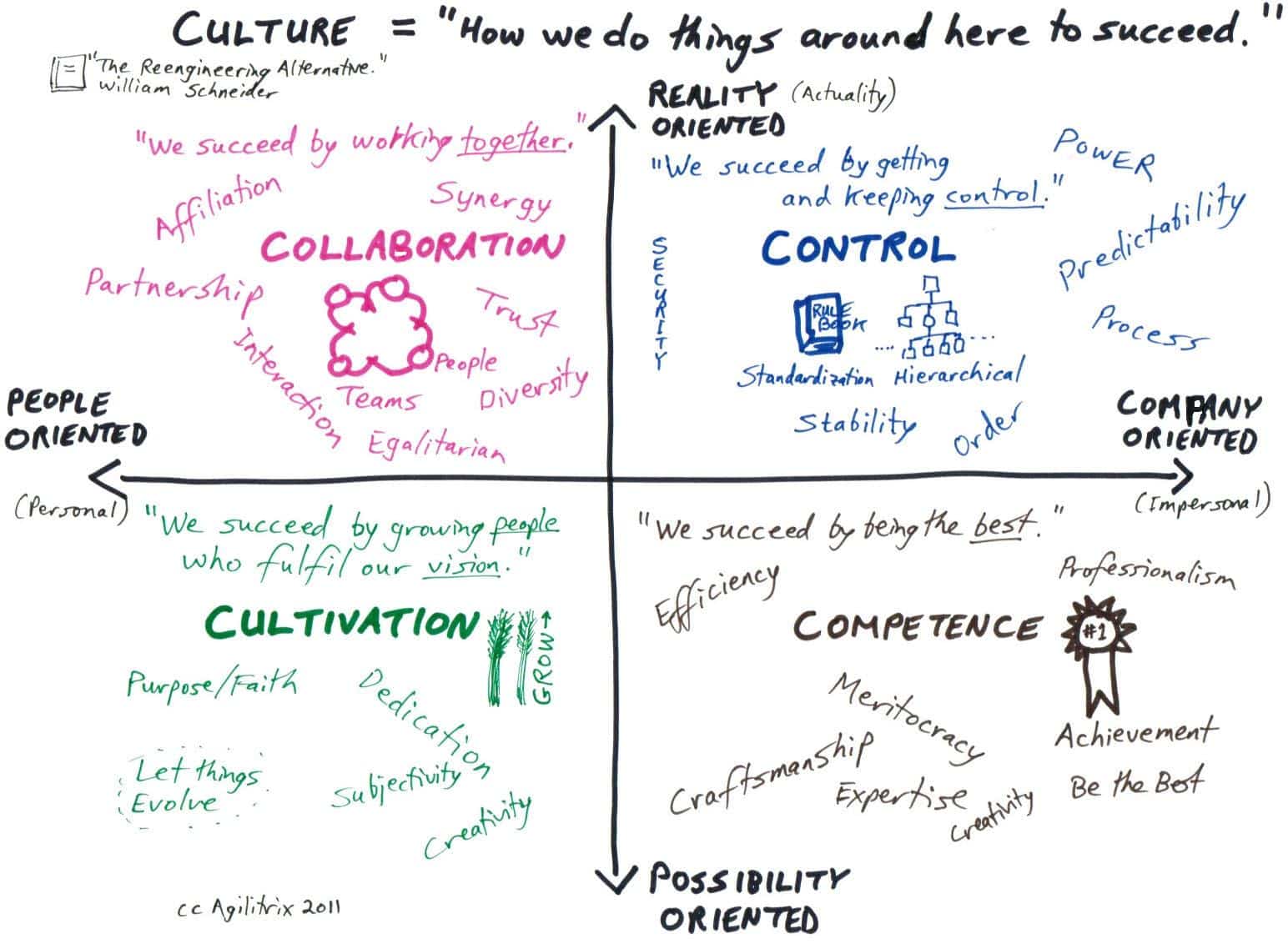
(Continued from Agile Change or Adoption Always Starts with Why: Part 1, Part 2)
Sense Your Current Culture
To understand the culture you’re attempting to change in your organization, you need to measure (or sense) the current state and then map that state to a model.
The model we will use is the Schneider Culture Model.[1] [2]
- Collaboration – a culture of working together
- Control – a culture of predictability and staying in control
- Competence – we’re the best at what we do
- Cultivation – a culture of learning and growth focused on a vision
These attributes are mapped on two axes: Horizontal – People vs. Company oriented; Vertical – Reality vs. Possibility oriented.

(Image by Michael Sahota, used with permission)
Each organization will have a primary and secondary culture. Agile and Scrum are primarily collaborative, with a secondary focus on cultivation. [3]
To sense where your organization fits in, you can either use a questionnaire (sample via Survey Monkey) or run a culture discovery workshop in conjunction with the questionnaire. My own experience, and that of Michael Sahota in “An Agile Adoption and Transformation Survival Guide”, suggests that using a workshop is more effective at creating a consensus around the results of the survey.
Case Study
For the past six months, WorldsSmallestOnlineBookStore has had trouble with customers leaving us or abandoning their shopping carts mid-purchase. We’ve figured out the technical sources of our problems, but nothing has been resolved. The executive team have been discussing them for months, and there is even some grumbling that Agile was “supposed to fix” the quality problem.
Of course, one of the bigger challenges that the teams perceive is that, while Scrum is being used at the team level, nothing is happening at the organizational level to support the changes that are needed. This doesn’t leave them with much faith overall.
In the above Case Study, a day-long workshop was held where attendees (a mix of Executives, Middle Management and Team Members) placed aspects of the current organizational structure, behaviours, practices and slogans on the Schneider model. The notes they added included:
Collaboration:
- We share knowledge with other teams
- The team ships, not the individual
- We welcome new ideas
- Our Scrum Teams are stable
Control:
- We need Red, Yellow, Green Reports to retain control
- Hierarchy matters – talk to your manager before going outside their span of control
- Annual Performance Reviews are important
- We use Stack Ranking and Rank and Yank to eliminate underperformers
- Ship features now
Cultivation:
- We use a skills matrix to identify strengths and weaknesses in the team. We use this information to help individuals learn.
- We hold lunch and learns
- We’ve created a community of practice to share new ideas. Example: https://www.infoq.com/articles/levison-TDD-adoption-strategy
Competence:
- Nothing in this section as they don’t currently put emphasis on Competence.
From this picture we can see that Scrum has truly taken hold at the team level, creating a culture of collaboration and cultivation. However the organizational structure remains stuck with a focus on control. If nothing changes, the control focus of the organization could destroy the collaborative culture the teams have built. We will discuss how to create a vision for change collaboratively with people from all levels of the organization, not just the executives, in the next post.
Other Frameworks to consider:
– Competing Values Framework (pdf)
– Laloux Cultural Model – Red (Centralized Structure), Orange (Achievement Oriented), Green (People) and Teal (Shared Power).
[2] See: Michael Sahota’s excellent summary here: https://www.methodsandtools.com/archive/agileculture.php
[3] Thanks to Michael Spayd for his research in this area
Leave a Reply